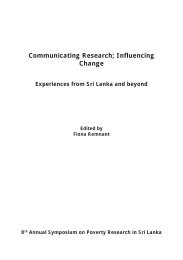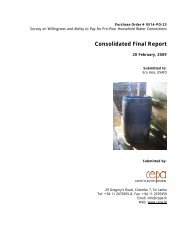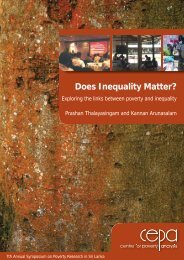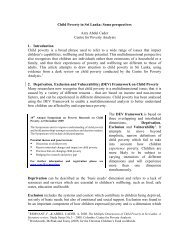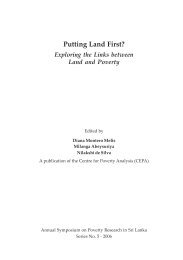Involuntary Displacement and Resettlement â Policy and ... - CEPA
Involuntary Displacement and Resettlement â Policy and ... - CEPA
Involuntary Displacement and Resettlement â Policy and ... - CEPA
- No tags were found...
Create successful ePaper yourself
Turn your PDF publications into a flip-book with our unique Google optimized e-Paper software.
The replacement of agriculture l<strong>and</strong> is very low. This is most prevalent withthe paddy cultivators, where 90% have not replaced their paddy l<strong>and</strong>. L<strong>and</strong>cultivated with cash crops show a slightly higher level of replacement. In afollow up after the first monitoring phase, cash crop households showed 65%of a recovery path. This reflects the importance of the agriculture incomesource to the household. Cash crops such as tea or cinnamon were a mainincome source <strong>and</strong> therefore replacement is vital for survival. On thecontrary, paddy is mainly for consumption <strong>and</strong> only the excess was sold fora supplementary income. The loss is felt less as a loss of income <strong>and</strong> moreas increased expenditure <strong>and</strong> therefore the replacement of paddy was not asvital as the replacement of cash crops.Non replacement of agricultural l<strong>and</strong> has occurred due to reasons related tohousehold decision making. Many agricultural l<strong>and</strong>s were of sharedownership <strong>and</strong> as such the compensation received was low.I wanted to buy a paddy l<strong>and</strong> <strong>and</strong> I have looked for a paddy l<strong>and</strong>. But mycompensation was not enough to buy as they asked 3 lakhs for the paddyl<strong>and</strong>. Now, those paddy l<strong>and</strong>s are very expensive.- Paddy farmer, HomagamaCommercial l<strong>and</strong>sFrom the affected people sampled in the study, 1.5% were those who hadlost ‘commercial property’ or business premises. There were a diverse rangeof businesses: 48% were retail <strong>and</strong> wholesale, 28% agricultural <strong>and</strong> foodprocessing, mining <strong>and</strong> services, <strong>and</strong> 15% were manufacturing. As most ofthe establishments were informal, these activities were either conducted athome or very close to it. As a result they were directly affected by the l<strong>and</strong>acquisition.Commercial enterprises are recovering at a slow pace. The phase 3 surveyfound that about 60% have decreased income, while the follow-up surveyfound that only 55% have restarted commercial activity. Often thereplacement is on a smaller scale than it was previously. The largerenterprises showed a greater tendency of restarting. A supporting factor forthis is larger compensation, on which they were able to subsist untilrecovery. In smaller enterprises, slower recovery is linked to the importanceof that income source to the household. This was evident where the primaryincome source of a household is a non commercial activity such asgovernment employment.50



